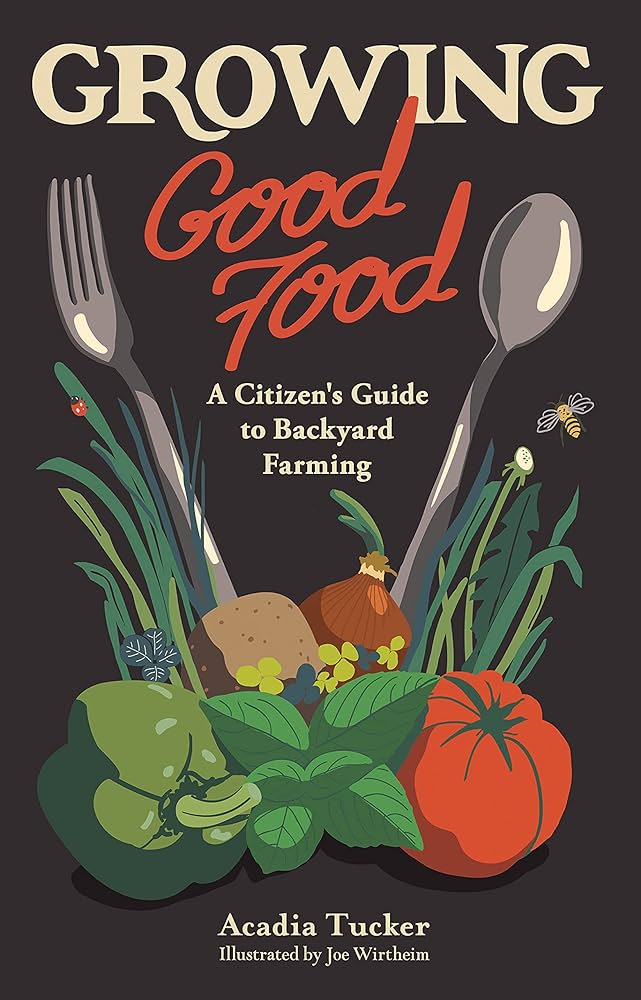[ad_1]
Title: Rising Good Meals, A Citizen’s Knowledge To Yard Carbon Farming
Creator: Acadia Tucker
Writer: Stone Pier Press
Promote your rototiller and ditch the factitious fertilizers. Plant an space local weather victory yard and luxuriate in a bounty of meals with so much a lot much less work.
Yard carbon farming and regenerative practices sound like huge concepts – and they also’re. Nonetheless creator and regenerative farmer Acadia Tucker needs each gardener to know that they’re really fairly simple concepts. If each gardener embraced them and planted a native local weather victory yard, we’d make a big contribution to reducing atmospheric carbon and slowing native local weather change. Plus, everybody would eat a whole lot additional healthful. The great thing about the thought is that the standard of the meals you develop is inextricably linked to bettering the native local weather. And that’s a win/win for everyone.
Tucker has a novel perspective on the native local weather disaster. Working as a farmer from Washington State to New Hampshire, she has seen radical, unpredicted shifts in native local weather that decimated delicate annual crops nonetheless spared perennials. She has furthermore seen the excellence it makes to these crops when soil consists of an abundance of pure provides vs historically farmed soil which doesn’t. It’s fascinating to be taught regarding the methods she and her companions employed to rehab an earlier plant nursery and the best way by which some typical strategies failed miserably. Expertise is definitely the right trainer.
What’s an space local weather victory yard?
Take into consideration the deep forest. Inside the event you’ve ever hiked into deep woods you understand how wonderful it’s – and that’s due to no of us interfered with the pure cycle of progress or additional importantly, the soil. Years of carbon-rich provides have fallen and decayed and are trapped there and would possibly maintain so for 1000’s of years, moreover and till it’s deforested. Crops develop perpetually, making a wealthy ecosystem, undisturbed and unaided by human fingers.
The thought-about an space local weather victory yard is “rooted” contained in the deep forest event. Perennial meals crops return 12 months after 12 months – these with a woody growth like fruit timber and raspberries retailer carbon, people who develop near the underside like strawberries act as a groundcover. If gardeners develop principally perennial crops like blueberries, raspberries, blackberries, strawberries, fruit timber, asparagus, rhubarb, spinach, potatoes, garlic, kales, lettuces, a number of herbs, and comparable crops, additional carbon is maybe saved contained in the crops and the soil. Planting perennials signifies that soil stays comparatively undisturbed for years after planting, creating pure matter contained in the soil, which feeds crops, retailers carbon, and manages water.
It’s attainable it’s possible you’ll not uncover that each one the crops talked about above can really be grown as perennials. Objects of potatoes may presumably be left contained in the flooring after harvest, as can garlic cloves to develop the following 12 months. Constructive sorts of onions will return 12 months after 12 months. One spinach plant, kale or lettuce left to go to seed creates many crops the following spring (merely make sure you plant an heirloom, not a hybrid alternative). Even peppers may presumably be grown perennially if the plant is launched indoors over the winter in areas that obtain frost.
Spherical half of the carbon launched into the setting yearly is absorbed by oceans, crops, and soil. Soil does plenty of the heavy lifting, storing 4 occasions additional carbon than crops. We interrupt this cycle by plowing it, stripping it of forests, spreading chemical substances on it, and leaving it naked, and this has horrible penalties. When soil degrades, the molecules that bind carbon break down, realeasing it as soon as extra into the air. As a substitute of absorbing carbon, depleted soil additional contributes to worldwide warming.
Regenerative practices develop meals in a technique that returns atmospheric carbon as soon as extra to the soil, a course of generally known as sequestration. And all of it begins with crops.Acadia Tucker, Rising Good Meals
In Rising Good Meals: A Citizen’s Knowledge to Yard Carbon Farming, Tucker lays out the fundamental plan for creating an space local weather victory yard that anybody can observe: mapping your web site, the place the right spot in your property is to start out your yard, creating raised beds, grooming your soil, sheet mulching, the fundamentals of composting, the becoming approach to begin crops indoors, which crops to develop, and far more.
By following Tucker’s recommendation, likelihood is you will contribute to carbon seize in your yard, regardless of its measurement, and luxuriate in a bountiful feast of fruits, herbs, and greens yearly. The irony is, as shortly as your perennial crops are established, you’ll do so much a lot much less work than within the occasion you happen to grew annual crops that wanted to get modified yearly and weeded and watered judiciously. That’s a fairly full lot from any viewpoint. As a lifelong gardener, I acquired proper right here to this conclusion years beforehand – I wasn’t fascinated regarding the carbon seize, nearly doing so much a lot much less in my yard (with age comes info).
Rising Good Meals furthermore contains calls to motion and insights from leaders contained in the regenerative motion, together with David Montgomery, Gabe Brown, and Tim LaSalle. Rising Good Meals: A citizen’s information to yard carbon farming is a companion to Rising Perennial Meals: A self-discipline information to elevating resilient herbs, fruits, and greens, furthermore written by Acadia Tucker.
[ad_2]
